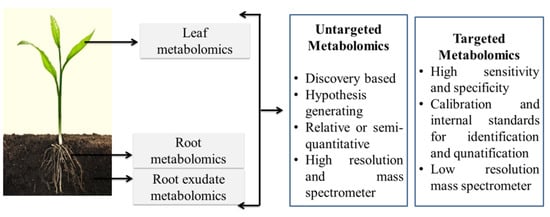Engineered nanoparticles can interact chemically and mechanically with plants. These interactions are based on their properties such as size, surface area, and catalytic interactions. Few studies have been reported regarding the effect of nanoparticles at the molecular level
[29][30][31][29,30,31]. Various plant species are highly affected by ZnO nanoparticles. Nanoparticles penetrate the plant leaf and accumulate in the edible parts while some assimilate into the soil in the surrounding area of the plant. Some metal and metal oxide nanoparticles are toxic to the environment, such as Ag
+1, Fe
+3, Zn
+2, Al
+3, and Ti
+4 [32]. It was observed that when
Brassica juncea was treated with silver nanoparticles it resulted in increased levels of antioxidant enzymes, for instance, guaiacol peroxidase, catalase, and ascorbate peroxidase, which resulted in decreased levels of reactive oxygen species (ROS) activity
[33]. The activity of enzymes such as super oxide dismutase, catalase, guaiacol peroxidase, ascorbate peroxidase, and glutathione reductase increased after the treatment of
Brassica juncea with gold nanoparticles
[34]. It was found that H
2O
2 and proline content increases in gold nanoparticle-treated plants. The activity of ascorbate peroxidase, glutathione reductase, and guaiacol peroxidase is stimulated in the presence of up to 400 ppm of gold nanoparticles, while on the other hand, the activity of guaiacol peroxidase increases with 200 ppm gold nanoparticles. Plant molecular responses to silver nanoparticle treatment were analyzed in
Aradidopsis by reverse transcription-polymerase chain reaction
[35]. A whole-genome cDNA expression microarray was also used for the transcriptional response analysis of
Arabidopsis plants subjected to silver nanoparticles. This resulted in the identification of 286 upregulated genes, including those involved with metal and oxidative stress responses such as the vacuolar proton exchanger, SOD, cytochrome P450-dependent oxidase, and peroxidase. It also identified about 81 downregulated genes along with genes that help in the plant defense system. These included auxin-regulated genes, ethylene signaling pathway, and SAR against pathogens.
Iron (Fe) is considered to be essential for plant growth and development as it plays a significant role in enzymatic reactions, helps in photosynthesis, and aids to improve the performance of photosystems. In plants, Fe is present in the insoluble form, i.e., Fe
3+. The increase in pH and aerobic conditions leads to a decreased concentration of Fe in the soil. The use of iron nanoparticles helps to improve plant resistance to different environmental abiotic stresses. The application of iron nanoparticles reacts at the molecular level of plants, which helps to enhance the nutrient uptake ability
[38]. Toxicity in plants may be caused by an excess concentration of iron nanoparticles. A higher amount of free Fe ions such as Fe
2+ and Fe
3+ leads to the production of ROS in plants. It was reported by Rodríguez et al.
[39] that in some plants, down-regulation of detoxifying proteins such as CAT2 (CATALASE 2; AT4G35090) protein and AP2 (PEROXIDASE 2; AT5G06720) protein has been observed. A deficiency of Fe in the roots of
M. truncatula,
P. dulcis, and
P. persica was correlated with superoxide dismutase expression, i.e., ATMSD1 (ARABIDOPSIS-SIS-MANGANESE SUPEROXIDE DISMUTASE 1; AT3G10920)
[39]. Fe deficiency may cause the production of non-enzymatic ROS. Under Fe deficiency in
A. thaliana, two enzymes have been reported to be expressed: GST1 (
ARABIDOPSIS GLUTATHIONE S-TRANSFERASE 1; AT1G02930) and MDAR1 (MONODEHYDROASCORBATE REDUCTASE 1; AT3G52880)
[40]. The ROS-eliminating enzyme aids in the stimulation of the ascorbate-glutathione cycle from GPX3 (GLUTATHIONE PEROXIDASE 3; AT2G43350)
[40]. Due to the magnetic properties of superparamagnetic iron oxides, Fe
2O
3 (maghemite) and Fe
3O
4 (magnetite) nanoparticles are widely used in various applications including the mitigation of salinity effects of plants. High Fe
3O
4 nanoparticle concentration has a high impact on seed germination and root elongation of cucumber
[41]. In cucurbits, the Fe
3O
4 nanoparticle aggregation occurred in the stem and roots
[42]. The toxicity of superparamagnetic iron oxide nanoparticles has been tested in
Lemna gibba [43]. It has been observed that plant chlorophyll content decreased while the photosynthetic activity and growth were also highly affected. The size and stability of nanoparticles are responsible for their toxicity level. The effect of Fe
3O
4 nanoparticles has been investigated in
Cucumis sativus, and it was observed that seed germination and root elongation were highly affected
[41]. It has been shown that Fe
3O
4 nanoparticles are translocated towards the foliage, stem, and below-ground root. Aggregation of Fe
3O
4 nanoparticles in plants may decrease the root hydraulic movement and water transport. The growth parameters of
S. lycopersicum were studied by the application of Fe
2O
3 nanoparticles. It has been observed that these nanoparticles were clogged in root hairs, root tips, and the nodal portion of plants. Increases in Fe
2O
3 nanoparticle concentration improved iron content in plants
[44]. In
Arachis hypogaea, root length and plant height increased due to the use of Fe
2O
3 nanoparticles in saline conditions
[45].
While a number of genes with the potential for the engineering of salt tolerance have been identified and tested, additional genes and regulatory pathways need to be identified. Work in many labs is ongoing to develop genomic, transcriptomic, proteomic, and metabolomic resources.

